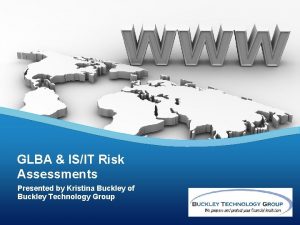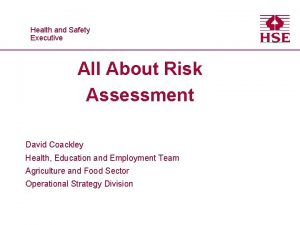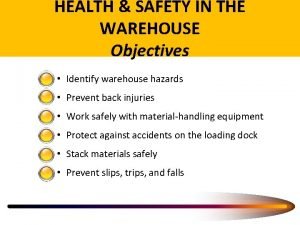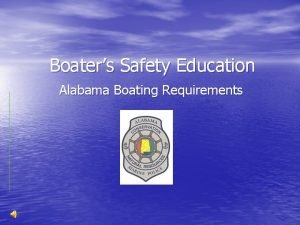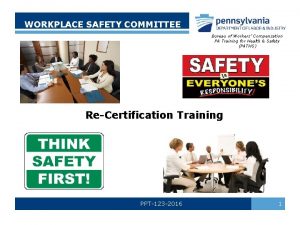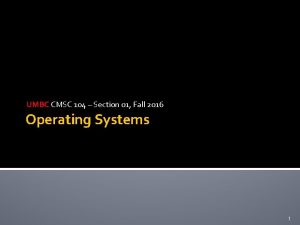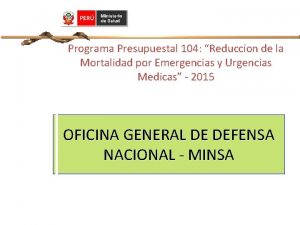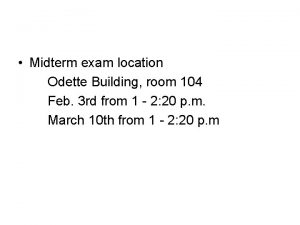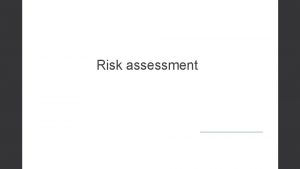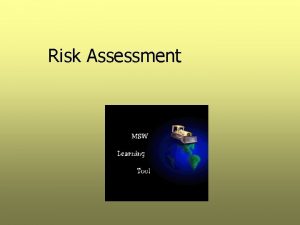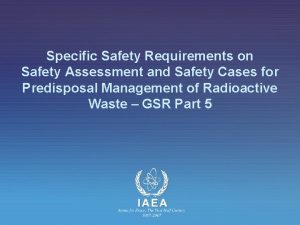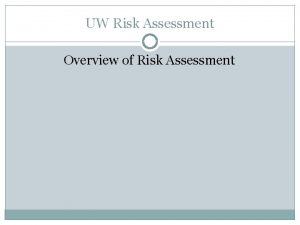GG 104 Requirements for Safety Risk Assessment Overview













- Slides: 13

GG 104 Requirements for Safety Risk Assessment Overview Ron Thompson

GG 104 Requirements for safety risk assessment • Provides a framework that sets out the approach for safety risk assessment when undertaking any activity that can have an impact on safety on the strategic road network. • Incorporates the guidance in IAN 191/16 on how to select an appropriate safety management system according to activity type categorisation.

GG 104 – GD 04/12 Key differences • Emphasis placed on it being applicable to all activities having a potential impact on safety. • Written in a more usable style that conforms to new Highways England drafting rules. • Identifying criteria for populations and considering risk exposure steps combined. No longer includes HSE tolerability of risk triangle. • Activity type classification features redefined and reordered to enable more realistic categorisations.

Requirements for safety risk assessment

• What is it you are trying to achieve? • What are the options being considered? • Identify stakeholders and consultees? • What governance arrangements does your business area have for safety risk assessment?

• Extent of prior experience of activity. • Statutory and formal processes and procedures (including standards and legislation). • Impact on the organisation. • Activity scale. • Technical. • Stakeholder impact and interest.

Vast majority • Type A (basic) safety management • Type B (moderate) safety management • Type C (rigorous) safety management Type A Type B Type C Relatively routine, familiar, no operational implications Could have significant operational implications Complex, unfamiliar, and major implications for the SRN Increasing levels of effort and detail in safety risk management

Population People directly employed by Highways England who work on the motorway and all-purpose trunk roads either permanently e. g. Traffic Officers, or periodically e. g. those undertaking site visits. AND People in a contractual relationship with Highways England, including our National Vehicle Recovery Contract operatives, all workers engaged in traffic management activities and incident support services, and any other activities where traffic is present, such as persons carrying out survey and inspection work. All road users, including the police and emergency services, equestrians, cyclists and pedestrians, as well as those others, who are at work but are not in a contractual relationship with Highways England such as privately contracted vehicle recovery and vehicle repair providers. Other parties includes any person or persons who could be affected by the Highways England motorway and all-purpose trunk roads, but who are neither using it, nor working on it i. e. living or working adjacent to the motorway and allpurpose trunk roads, using other transport networks that intersect with the motorway and all-purpose trunk roads Classification Workers Users Other parties

• What is the safety question you are trying to answer? • What is the extent of the question, physically, geographically or timewise • Each option being considered needs risk assessment. • How are each of the exposed populations affected by each option? • How complex is the activity and what level of experience do we have?

Quantitative • What are the current exposure levels? • This is most often illustrated with statistical data such as KSI rate or FWI rates. • The measure selected for the baseline and the safety objective should be the same for the purposes of comparison • For road workers the overriding ALARP principle is to be satisfied; the safety objective for road workers should be set on this basis (Safety Risk Model outputs)

• Identify the reasonably foreseeable hazards associated with the activity. • Analyse the hazards to understand the safety risks and consequences if risks are realised. • Assess the likelihood of the risk being realised potential severity of the consequences to give a risk value. • Compare the risk values against the baseline and objective. • Determine any mitigation required to achieve this or ALARP. • Evaluate effect of mitigation measures until safety objective and or ALARP is achieved.

• All steps of the safety risk assessment and any decisions made. • All supporting evidence used to justify decisions. • Any assumptions made and the basis for them. • Update the safety risk assessment throughout the life of the activity. • Review if anything changes that affects the activity or any part of it. • The documentation should be retained for at least the life expectancy of the activity in line with business area safety risk governance requirements.

• To validate the decisions made and ensure any safety risk mitigations are performing as expected. • The detail of any residual risks that require active monitoring shall be recorded an owner assigned. • Assumptions made in relation to the safety risk assessment, will need to be validated as part of the review. • For type A categorised activities it is acceptable for monitoring to be a part of routine performance measurement.
 Glba risk assessment
Glba risk assessment Liquidity measures
Liquidity measures Health and safety risk assessment template
Health and safety risk assessment template Safety assessment for ind safety reporting
Safety assessment for ind safety reporting Warehousing health and safety
Warehousing health and safety Alabama boaters test
Alabama boaters test Safety training for housekeeping staff ppt
Safety training for housekeeping staff ppt Cmsc 104 umbc
Cmsc 104 umbc Programa presupuestal 104
Programa presupuestal 104 Lativ104
Lativ104 Calculus with analytic geometry examples
Calculus with analytic geometry examples Odette building 104
Odette building 104 Biology
Biology Psalm 104
Psalm 104
